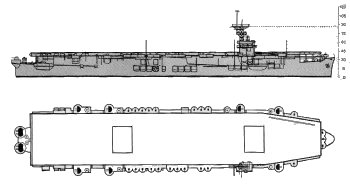![]() The Pacific War Online Encyclopedia
The Pacific War Online Encyclopedia
|
| Table of Contents |
|  ONI 222 |
| Tonnage | 11,412 tons standard displacement |
| Dimensions | 553' by 75' by 32' 168.6m by 22.9m by 9.8m |
| Maximum speed | 19.3 knots |
| Complement | 1080 |
| Aircraft | 502' (153m)
flight deck 1 catapult 2 elevators 25 aircraft |
| Armament | 2 5"/38
dual-purpose guns 4x2 40mm Bofors AA guns 12 20mm Oerlikon AA guns |
| Machinery |
2-shaft Allis-Chalmers geared
turbine (13,500
shp) 4 Babcock and Wilcox boilers |
| Bunkerage | 12,876 tons fuel oil 135,000 gallons (510,000 liters) aviation gasoline |
| Range | 23,900 nautical miles (44,300 km) at 15 knots |
| Cargo | 676.5 tons munitions |
| Sensors |
SC search
radar |
| Modifications |
1944: Second catapult installed. 1945: Armament typically 10x2, 2x4 40mm and 27 20mm guns. Radar upgraded to SC-2 or SK |
The Sangamons
were completed in 1942 and were
converted Maritime
Commission T3-S2-A1 oilers, the supply of convertible C3 hulls having already been
exhausted with the Bogues. The Sangamons were also tough ships,
with very great
hull strength. Their hangars were actually more capacious than those
of the Independence-class
light fleet carriers,
and they were the only escort carriers
with decks long
enough to permit the operation of F6F
Hellcat
fighters. The open hangar design,
characteristic of all U.S. carriers, also allowed these ships to
continue to function as oilers when necessary. They thus had a
remarkable range and the ability
to refuel their own task groups. They had bulkheads
around their magazines that provided some splinter protection.
|
Arrived 1942-12-12 |
|
| Chenango | Arrived 1942-12-25 |
| Sangamon | Arrived 1943-1 |
| Santee | Arrived 1943-2-18 |
References
The Pacific War Online Encyclopedia © 2007, 2009, 2012 by Kent G. Budge. Index